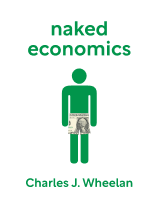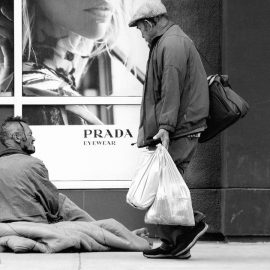

This article is an excerpt from the Shortform book guide to "Naked Economics" by Charles J. Wheelan. Shortform has the world's best summaries and analyses of books you should be reading.
Like this article? Sign up for a free trial here .
What are economic incentives? What are the key forces that drive the behavior of economic agents?
Economics is based on the assumption that incentives drive the market. This means the incentives of both individual people and also individual firms, each of which are working to benefit their own particular well-being.
In this article, we’ll explore the incentives of both firms and individuals and some ways in which incentives can work poorly, distorting the market instead of allowing it to function properly.
People Work to Benefit Themselves
The first assumption of economics is that people will do what they can to maximize their utility. “Utility” can be thought of as happiness, and maximizing it means making yourself as well-off as possible.
Utility means different things to different people. Different people have different priorities, and when you maximize your utility, you’ll balance life’s competing influences differently than other people will. People make different decisions based on how they prioritize the following dichotomies:
- Immediate needs versus future needs: When people resist spending money on pleasurable items one day in order to save for a bigger item a few months from now, they trade utility now for utility later. Balancing immediate with future happiness isn’t limited to purchasing decisions; for example, when people voluntarily receive a flu shot, they accept short-term pain now for protection against disease later.
- Work versus leisure: The more a person works, the more income she’ll have to fund more enjoyable activities. But if she allocates too much of her time to work, she’ll have less time to spend on those activities. She’ll maximize her utility by finding a balance between the two enterprises.
- Your own needs versus others’ needs: Sometimes people find happiness not by purchasing things for themselves but by acting altruistically, by, for example, donating to charitable causes. In extreme examples, they may put their own lives at risk to save others, even strangers—as in the case of Wesley Autry, a construction worker in New York City who jumped onto a subway track in 2007 as a train approached to save a complete stranger who’d fallen onto it.
- Physical needs versus psychic needs: If you choose a job teaching second grade instead of marketing cigarettes, you will probably earn less income but you may also feel better about your contribution to the world, earning you psychic benefits that justify your smaller paycheck.
Whatever a person’s individual priorities, a capitalist market allows her to make decisions to satisfy them. And in the same way that the market, in general, maximizes the productivity of its resources, individuals will do the same. As an example, George Clooney would surely have been an excellent car salesperson. But his unique resources—his looks and charisma—could be more productive, and earn him a higher income, being put to use as an actor. He therefore maximized his utility by choosing the career he did.
People Sometimes Behave Irrationally
Although economics assumes that people do things to make themselves better off, this doesn’t mean that they always succeed at these efforts. Sometimes people do things that feel like a good idea but actually harm them. This is often because people don’t consistently act rationally to better themselves. Instead, they act emotionally, and in doing so, make several common mistakes:
- People give in to temptations of short-term pleasure that will harm them in the long run: For example, people smoke or overeat, even though they know these things will increase their chances of future illness.
- People believe when things are going well, they’ll always go well: This can lead people to make poor decisions. The financial crisis of 2008 illustrated this tendency: People continually invested in housing because prices were rising, and they chose to believe that prices would continue to rise indefinitely.
- People misunderstand risk and probability: People underestimate certain risks while overestimating others because certain risks “feel” scarier—for example, people are often more afraid of flying than riding on a motorcycle, even though a motorcycle trip is 14 times more likely to be fatal. When people don’t properly understand the possible consequences of their decisions, they make poor choices.
(Shortform note: For an in-depth discussion of how and why people misunderstand risk and probability, read our summary of Fooled by Randomness.)
Firms Work to Benefit Themselves
The second assumption of economics is that firms work to maximize their own utility, which typically means profits. They must make choices when doing so, designed to meet the desires of their potential customers while competing with other firms offering similar products. Some of the choices they face include:
- What to produce
- How to produce it
- How much to produce
- What price to sell it at
For each of these choices, firms must balance how to best allocate their own resources—time, money, assets, knowledge, and labor. Each firm will balance these resources depending on its unique situation. For example, in the United States, labor is expensive but machinery is relatively affordable for firms, so you’ll see a landscaping company hiring a small team of people to work complex, efficient machines like ride-on mowers. In other parts of the world, the opposite is true: Machinery is unaffordable but labor is cheap, so you might find a large team of people cutting a lawn by hand, using sickles.
Prices Regulate the Interactions of People and Firms
Prices are the mechanisms through which people and firms decide how much each can benefit from the market and from each other. Firms and individuals connect when a sale is made. These connections are regulated by prices, which reflect the supply and demand for any item on sale: how much of something is available and how much people want to buy it.
When sellers and buyers settle on a price that reflects a balance between supply and demand, they’ve set the market price for that particular thing, where its price encourages enough demand from buyers to generate an acceptable amount of profit for the seller. There is often a complex process involved in arriving at that price: In general, when prices increase, fewer people buy that thing, so the demand drops relative to its supply. If demand drops enough, vendors respond by lowering the price. When the price drops, people start buying that thing again, which increases demand, which in turn increases prices again.
When setting prices, vendors must anticipate demand and try to set their prices to best encourage and capitalize on it. They must strike a balance: Too much demand, and vendors run out of supply. Too little demand, and vendors sit on unsold supply.
Because of the constant adjustments sellers make to find an item’s market price, most markets are self-correcting; that is, when supply and demand get out of line with each other, market pressures, fueled by prices, generally push them back into place.
Some industries adjust almost instantaneously to these influences of supply and demand, driven by real-time changes in buyer preferences. The stock market is one such industry: For any company, there will be a finite number of shares for sale (supply) and a certain number of buyers (demand). As the number of buyers fluctuates, the market price for those shares adjusts automatically.
However, most industries don’t react so directly to customer demand, but instead determine prices through company decisions. Company executives try to predict customer demand and how it will affect profits. In doing so, they try to find a price high enough to make a profit but low enough to encourage demand. For example, if a company offers a shirt for $10, they may sell out of it but only net a small profit off each shirt. However, if they charge $100, they may make a large profit off each shirt, but they may sell very few of them, resulting in a warehouse full of unsold shirts and an overall profit loss.
The Market Rewards Scarcity
Prices are driven by what people want to buy, and in a free market, this is more of a reflection of scarcity than of importance or need. For example, people pay high prices for diamonds, which are scarce, even though they can’t sustain life—but water, without which we can’t live without, is practically free because it is plentiful.
Prices Are Only One Aspect of Cost
Prices only reflect one aspect of what people actually pay for something. There are subtle costs involved in any transaction that the listed price either reflects or is discounted by. For example, an expensive pair of shoes in a store near your office might not actually be more expensive to you than the cheap shoes in a shopping mall an hour’s drive away, if you have to give up paid working time to go get the “cheaper” shoes. Similarly, a “free” ticket to a play isn’t truly free if you have to stand in line for eight hours to obtain it.
There are additional, societal, costs to an item as well. These costs are even more subtle and harder to quantify. The cost of a car isn’t merely its price tag—it’s also the price your children will pay to clean up the pollution your car produces. We’ll discuss how governments are involved in managing and accounting for these types of costs in Chapters 3-4.
People Incentives Can Distort the Market
Economic incentives are what drive the behavior of economic agents. In general, self-interested incentives help an economy work well—in the pursuit of personal income, people and firms produce goods and services that benefit others. But sometimes, incentives drive people to do things that harm the economy or to behave poorly. This happens either when people misunderstand incentives or when well-meaning incentives produce unintended consequences. The following sections examine some ways incentives can go wrong in both the private and public sectors.
Incentives in the Private Sector
Corporate America is riddled with competing and misaligned incentives, which commonly manifest in one of two ways:
- The Principal-Agent problem
- The Communal Resource problem
Each of these is discussed below.
The Principal-Agent Problem
The Principal-Agent Problem is when two people who are working together in an employer/employee dynamic have differing goals, leading to problems for the long-term stability of a company.
When a company (a principal) employs someone (an agent), they often have differing motivations. The principal wants to make money off their customers, but the agent might want to make money off the company (over and above a salary). For example, a fast-food restaurant wants to profit from food sales, while a cashier might want to pocket the money from the transaction for herself. (This is one reason some fast-food restaurants tell customers that if they don’t get a receipt, their meal is free—it ensures that cashiers are running transactions through the register.) These misaligned incentives exist at the higher levels of the corporate world, too: Executives have an incentive to, for example, use company money for corporate cars, jets, and vacations.
Misaligned incentives are what
can influence important business decisions, which can have serious repercussions for a company’s future. For example, CEOs have a strong incentive to engineer corporate mergers, since running a larger company brings them personally more status and income. Unfortunately, two-thirds of such mergers don’t increase the value of either company involved, and one-third actually decrease it. Thus, while the CEOs benefit, the shareholders they supposedly work on behalf of don’t.
The principal-agent problem also manifests when an employee takes risks with company money assuming that if those risks go bad, the employee herself won’t shoulder the consequences; the company will. This is partly what drove the housing bubble leading up to the financial crisis of 2008—tens of thousands of investment bankers buying up shaky loans at the investment firm’s expense.
Solutions to the principal-agent problem can create their own problems of distorted incentives. For example, corporations often try to align their employees’ interests with their own by offering stock options, whereby an employee is given the option to sell a certain number of shares if the share price rises above a particular price. The thinking is that employees will then work to increase the market value of the company. However, this only incentivizes top executives to artificially drive up a stock’s short-term price so that they can cash out when the value is high. If the measures they took to drive up that price ultimately weaken a company, well, that’s someone else’s problem.
Even when two parties working together have very similar incentives, the principal-agent problem can still arise: for example, when you contract with a real estate agent to sell your home. It benefits you both to sell the house at a good price, but with one caveat—your realtor is incentivized to price your home a little low and move it quickly so she can move onto selling the next home, while you’re incentivized to price it high and wait longer for a better offer.
Communal Resource Problems
Individual incentives can create problems in markets built around communal resources. Communal resources are finite resources of which everyone uses a piece, but no one in particular owns—such as fish in the ocean. Systems based on such resources distort incentives because personal incentives rarely align with the incentives of the larger group, and often, people have incentives to cheat the system. For example, while it benefits all fishermen as a group when each individual fisherman limits her catch (because if everyone limits their catch, the fish supply will last forever), it benefits each individual to catch as many fish as she can before the other fishermen do (which depletes the fish supply and destroys the resource for everyone).
Usually, the only solution to problems of common resources is governmental regulation ensuring that no one party is able to take more than their fair share. However, such incentives have to be designed properly or they exacerbate the problem. For example, when Massachusetts tried to slow the depletion of fish stocks off the Cape Cod coast by imposing an overall, aggregated limit of how many striped bass could be caught by all fishermen collectively, it incentivized each fisherman to catch as many as she could as early in the season as she could, depleting fish stocks even faster.
Contrastingly, the coastal community of Port Lincoln in Australia established more effective incentives to protect their local lobster population: The community created licenses that set quotas for each individual fisherman, rather than for the group as a whole, thus allowing each operator to catch lobsters throughout the season without the fear that others will top out the quota first. Fishermen can also sell their licenses, turning them into a retirement plan—a license purchased for $2,000 in 1984 might sell today for close to $40,000. This gives individual fishermen a personal stake in the industry and therefore an incentive to protect it; their license will only be valuable if the lobster stock remains healthy. These regulations have enabled generations of fishermen to make a living.
Incentives in the Public Sector
This leads us to consider the role of government in setting incentives, for as the above examples illustrate, sometimes problems can arise when individuals act in their own self-interest. It’s then that the government must step in to regulate.
To create good policies that address societal or market-based problems, lawmakers must harness incentives wisely to direct peoples’ behavior in the desired way. This is difficult, and lawmakers often either ignore incentives or wrongly predict how incentives will change a person’s behavior. They therefore create policies that have unintended consequences, worsening the very problems they’re trying to solve—or creating brand new problems.
For example, Mexico City tried to solve their smog problem by ruling that all cars had to stay off the streets on one day every week. The government enforced the law by regulating license plates: Plates ending in, for example, 5 couldn’t be driven on Mondays. However, instead of limiting their driving habits, people simply bought second cars with different license plates. The ultimate effect of the policy was more cars on the roads, not fewer.
This isn’t to say that governmental intervention always gets it wrong. When done properly, restrictions can produce their intended results. For example, London also tried to reduce traffic in the city center by charging a congestion fee for all drivers entering a certain perimeter. The regulation worked well, lowering traffic by 15 to 20 percent.
Use a Broad Brush
Why did the London example work while the Mexican efforts didn’t? It might be because the Mexican restrictions were too narrowly focused on one particular segment of the market—cars with certain license plates—which made the restrictions easy to skirt, while the London fees applied to all vehicles that entered the city center during certain hours, making the restrictions much more difficult to avoid. In general, broad restrictions are more successful because there are fewer exceptions within them that people can manipulate.
Another benefit of broad restrictions is that when responsibilities are spread among many people, each person’s responsibility is small, reducing the incentive to evade it. For example, if everyone is charged a small fee to cross a bridge, no one really minds. But if only, say, silver cars are charged a fee, and it’s a high enough fee to subsidize everyone else, then people will simply switch from driving silver cars to cars of other colors.
Ignoring Incentives Distorts Them
While incentives in a capitalist economy may not always get it right, they mostly do. Capitalism may be a flawed option, but it’s better than the others available.
Take, for example, communism, where production is separated from self-interest. In a communist economy, a company offers and prices goods based on instructions from a central authority. Additionally, that central authority pays firms a predetermined set price, which the firms receive no matter how many goods they produce or sell. In such a system, where firms and people aren’t rewarded for hard work, people work less and don’t bother innovating or becoming more efficient. A striking illustration of this was the state of East German car manufacturers at the time of the fall of the Berlin Wall; they were operating so inefficiently that the cars they produced were worth less than the steel they contained.
You don’t have to descend into full communism to see how ignoring self-interest creates perverse incentives. The American public school system ties wages to seniority and rigorous certification rules rather than to performance, even though seniority and certificates have not been shown to benefit students. Because such a system doesn’t reward performance, it creates a process of adverse selection, whereby the most talented individuals select themselves out of the field, since their talents won’t be properly rewarded in that industry.

———End of Preview———
Like what you just read? Read the rest of the world's best book summary and analysis of Charles J. Wheelan's "Naked Economics" at Shortform .
Here's what you'll find in our full Naked Economics summary :
- An explanation of economics that anyone can understand
- How governments and firms can use incentives to foster a healthy economy
- How and why people behave in certain ways






